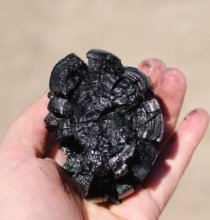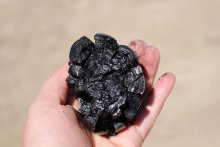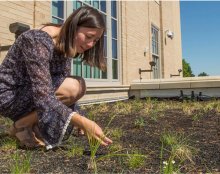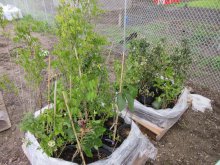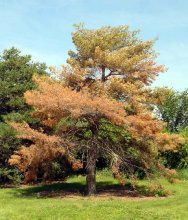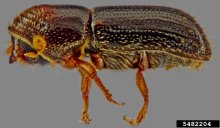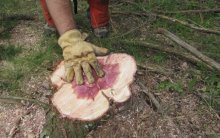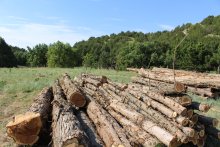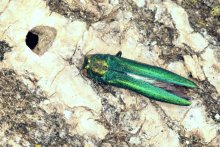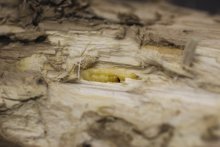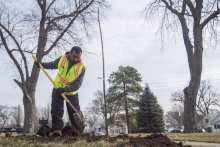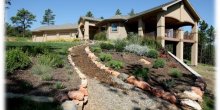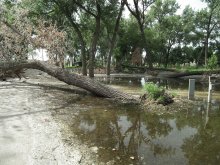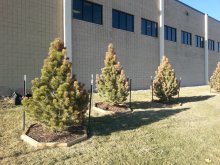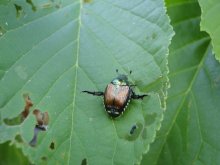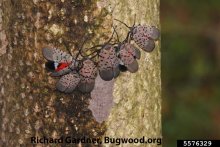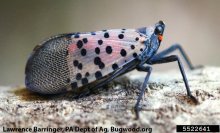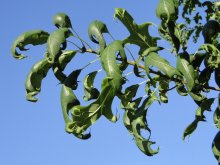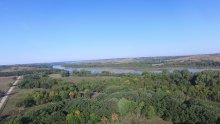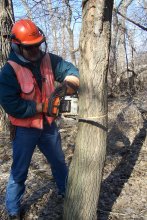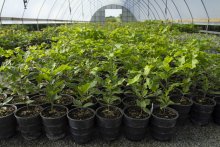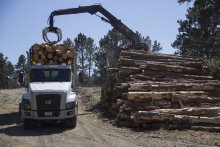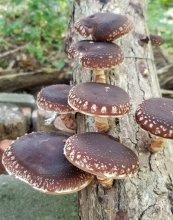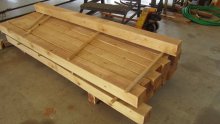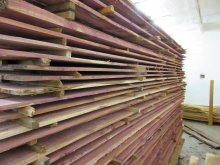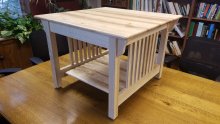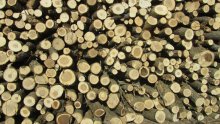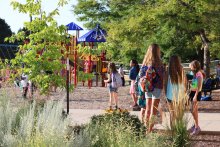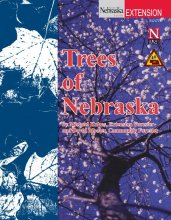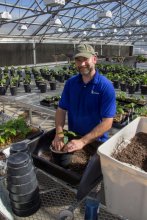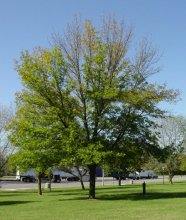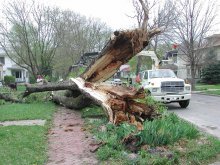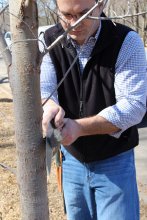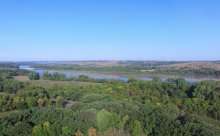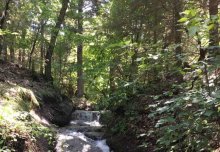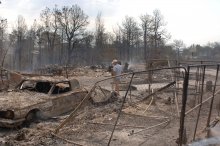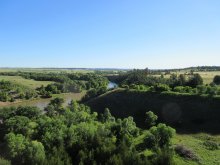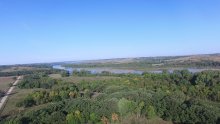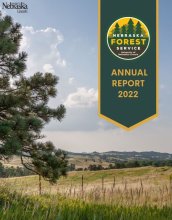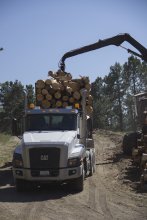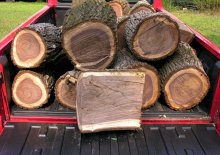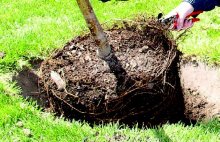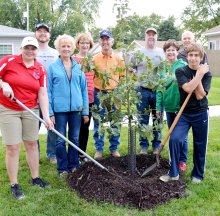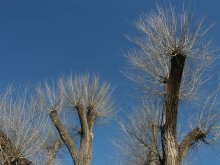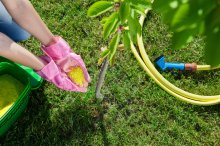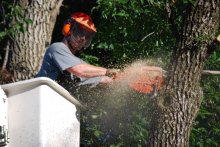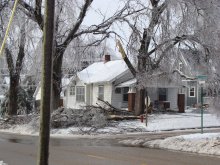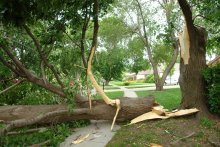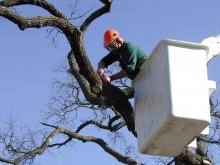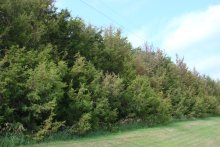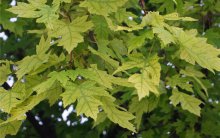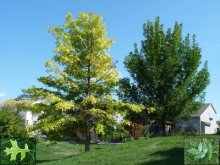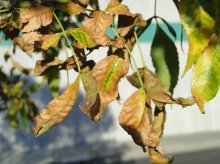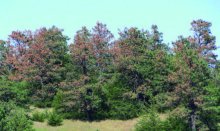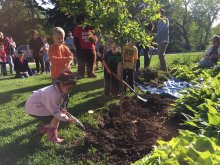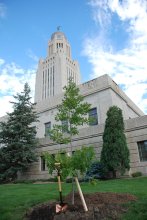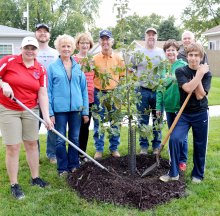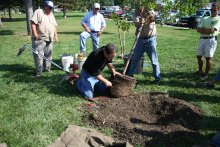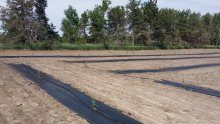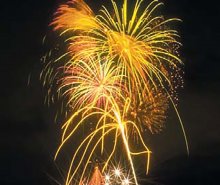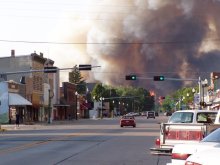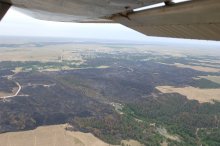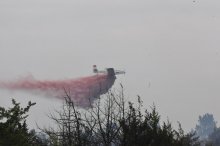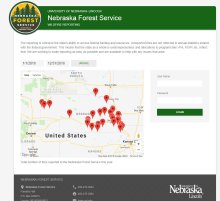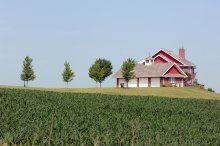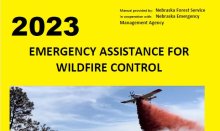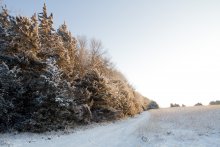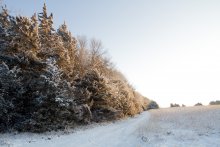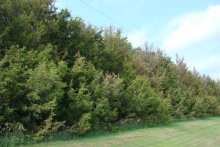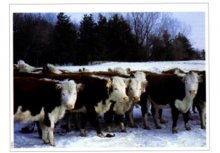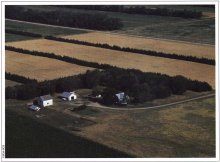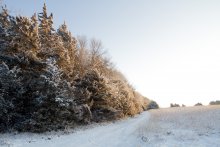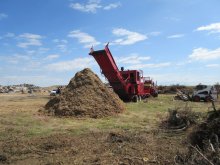Biochar
Combined heat and biochar (CHAB) technologies are systems that optimize the combustion of wood residues. The process of combusting
Read more about Combined Heat and BiocharIn 2017, the Nebraska Forest Service along with partners Kansas Forest Service, High Plains Biochar, and Wilson Biochar Associates
Read more about Great Plains Biochar Initiative“Green roofs” are an increasingly popular practice that can accomplish a wide variety of jobs in the urban landscape. Whether you are
Read more about Green Roofs: Biochar and YouNebraska is home to a wealth of untapped resources, some that are viewed as problematic. Nebraska has 1.3 million acres of forested land
Read more about Small Scale BiocharDiseases
Scotch pine, a popular tree for ornamental plantings, windbreaks and Christmas trees, is rapidly disappearing from Nebraska's landscape.
Read more about Pine Wilt: A fatal disease of Scotch PineThe Nebraska Department of Agriculture announced May 14th that walnut twig beetle, a carrier of a fatal disease of walnut trees,
Read more about Walnut Twig Beetle & Thousand Cankers DiseaseEastern redcedar
Eastern redcedar, Juniperus virginiana, is a native tree that has always been a fixture on the Nebraska landscape, providing
Read more about Eastern Redcedar in Nebraska: Nebraska Conservation RoundtableEastern redcedar management has become a topic of much discussion. Identifying utilization and wood products opportunities for redcedar
Read more about Redcedar UtilizationEmerald ash borer
There are many bright metallic-green insects in Nebraska, but the emerald ash borer beetle is only a half-inch long and strictly
Read more about Emerald Ash Borer Look-AlikesRegardless of the decision made, trees should not be left standing until they are dead or have significant dieback. Ash trees
Read more about Pros and Cons of EAB TreatmentSoil treatments are applied to the soil around the base of a tree. The chemical is picked up by the roots, carried up the
Read more about Soil Treatments Emerald Ash Borer: Information for HomeownersEspañol
Las condiciones ambientales en Nebraska dificultan que muchos árboles sobrevivan o crezcan bien. Varias condiciones como los tipos de
Read more about Árboles para NebraskaFirewise
Homeowners value landscapes for the natural beauty, privacy, shade, and recreation they offer and frequently select properties that
Read more about Firewise Landscaping PracticesFlooding
Even under the best of circumstances, half of a tree’s living tissue is under the soil and out of sight. Since the root system is the
Read more about Inspecting Flood Damaged TreesWater is critical to the growth and survival of trees. We often discuss what happens when trees and other plants become dry, but what
Read more about What can you do about flooded trees?Forest health
Nebraska is well known for being a land of extreme temperature swings. It isn’t uncommon in Fall or Spring to go from a nice day to a
Read more about Early and Late Frosts and FreezesThe Japanese beetle is a highly destructive invasive pest that is an annual problem for many Nebraskans. Its presence has grown over the
Read more about Japanese Beetle in NebraskaSpotted Lanternfly (Lycorma delicatula) is an aggressive invasive species that is present in several states. It is currently
Read more about Spotted Lanternfly - What to Look ForSpotted Lanternfly (Lycorma delicatula), is a new invasive species that poses one of the largest threats to American agriculture
Read more about Spotted Lanternfly Look-alikes (Not yet present in Nebraska)Forest management
Even under the best of circumstances, half of a tree’s living tissue is under the soil and out of sight. Since the root system is the
Read more about Inspecting Flood Damaged TreesHerbicides can be effective tools for controlling unwanted weeds in the landscape. However, in recent years, the Nebraska Forest Service
Read more about Herbicide Damage to TreesEastern redcedar, Juniperus virginiana, is a native tree that has always been a fixture on the Nebraska landscape, providing
Read more about Eastern Redcedar in Nebraska: Nebraska Conservation RoundtableForests cover 947,000 acres in Nebraska. Other land with scattered tree cover, including narrow wooded strips along streams, windbreaks,
Read more about Forestry Best Management Practices For NebraskaNebraska’s forests, also known as woodlands, comprise three percent of the total land base in the state. On an acre by acre comparison,
Read more about Managing Your WoodlandsEastern redcedar management has become a topic of much discussion. Identifying utilization and wood products opportunities for redcedar
Read more about Redcedar UtilizationForest products
Eastern redcedar management has become a topic of much discussion. Identifying utilization and wood products opportunities for redcedar
Read more about Redcedar UtilizationNebraska is home to a large horticulture nursery and greenhouse industry that produces a variety of products including aquatic plants,
Read more about Heating a Greenhouse with Woody BiomassCombined heat and biochar (CHAB) technologies are systems that optimize the combustion of wood residues. The process of combusting
Read more about Combined Heat and BiocharHealthy forests and strong markets are dependent upon active, responsible forest management. Markets for wood and forest products lead to
Read more about Forest Products Utilization ProgramIn 2017, the Nebraska Forest Service along with partners Kansas Forest Service, High Plains Biochar, and Wilson Biochar Associates
Read more about Great Plains Biochar Initiative“Green roofs” are an increasingly popular practice that can accomplish a wide variety of jobs in the urban landscape. Whether you are
Read more about Green Roofs: Biochar and YouMost of us have probably heard of our friends or neighbors hunting for mushrooms, oftentimes combing woodlands for the elusive morel each
Read more about Mushrooms in NebraskaNebraska has 1.5 million acres of forest land that cover 3 percent of its land base, and most of this forest land can produce commercial
Read more about Nebraska Forest Products Industry Economic ContributionsNebraska is home to a small, yet storied forest products industry with many businesses having been in operation for generations.
Read more about Nebraska's Sawmill IndustryUrban wood is salvaged from tree removal operations typically due to tree mortality, disease, land development, storm damage or
Read more about Nebraska's Urban Wood IndustryNebraska is home to a wealth of untapped resources, some that are viewed as problematic. Nebraska has 1.3 million acres of forested land
Read more about Small Scale BiocharUnder the Forest Products Utilization program, Trees Heat Nebraska is the Nebraska Forest Service’s technical
Read more about Tree Heat NebraskaCommunities across Nebraska are increasing the management of their community forests in anticipation of emerald ash borer.
Read more about Urban Lumber ProductionGrants
There are several opportunities available for financial assistance with the Nebraska Forest Sevice. Each grant has its own unique
Read more about Financial Assistance and GrantsGreenhouse
Nebraska is home to a large horticulture nursery and greenhouse industry that produces a variety of products including aquatic plants,
Read more about Heating a Greenhouse with Woody BiomassGuides
This manual will show you how to identify 97 tree species by comparing leaves, twigs, fruit, bark, and other parts. You will learn how to
Read more about Trees of NebraskaHazelnuts
The goal of hazelnut research is to accelerate commercial development of the hybrid hazelnut as a profitable, environmentally friendly
Read more about Commercializing Hybrid HazelnutsHerbicide damage
Herbicides can be effective tools for controlling unwanted weeds in the landscape. However, in recent years, the Nebraska Forest Service
Read more about Herbicide Damage to TreesInsects
The Nebraska Department of Agriculture announced May 14th that walnut twig beetle, a carrier of a fatal disease of walnut trees,
Read more about Walnut Twig Beetle & Thousand Cankers DiseaseEmerald ash borer (EAB) is a highly invasive, non-native insect that attacks and kills all species of North American ash trees, including
Read more about Emerald Ash Borer Frequently Asked QuestionsNut production
The goal of hazelnut research is to accelerate commercial development of the hybrid hazelnut as a profitable, environmentally friendly
Read more about Commercializing Hybrid HazelnutsPruning
Storm damage to large trees can cause large problems. These problems can exist immediately after the storm or become evident many months
Read more about Pruning Large TreesPruning is one of the most important tree maintenance practices. Over the years, the way in which we, as foresters, have approached
Read more about Pruning TreesReports
Eastern redcedar, Juniperus virginiana, is a native tree that has always been a fixture on the Nebraska landscape, providing
Read more about Eastern Redcedar in Nebraska: Nebraska Conservation RoundtableDownload the PDF to read about the accomplishments and highlights of the Nebraska Forest Service in 2018.
Read more about 2018 Annual ReportNebraska boasts a diverse array of forest resources. From the ponderosa pine forests of the Panhandle’s Pine Ridge to the hardwood
Read more about Forest Health 2017Nebraska boasts a diverse array of forest resources. From the ponderosa pine forests of the Panhandle’s Pine Ridge to the hardwood
Read more about Forest Health 2018This comprehensive report summarized the current understanding of climate change science, projected changes in climate for Nebraska, and
Read more about Implications of Climate Change for NebraskaMany Nebraskans would be surprised to learn that in our largely agricultural and grassland state, unique and diverse forest resources are substantial and growing.
Read more about Nebraska Forest ResourcesThe second full annual inventory of Nebraska's forests reports more than 1.5 million acres of forest land and 39 tree species. Forest
Read more about Nebraska's Forests 2010Thank you to our partners for all their support as we tackle the daunting challenges facing trees and forests. We are making excellent
Read more about NFS Annual Report 2021During 2022, Nebraska faced a significant year for both challenges and achievements. Our state’s forest and tree resources faced threats
Read more about NFS Annual Report 2022Increased utilization of wood waste can help decrease our Nation's dependence on foreign energy purchases, generate energy cost-savings,
Read more about Woodwaste Supply & UtilizationSpotted Lanternfly
Spotted Lanternfly (Lycorma delicatula) is an aggressive invasive species that is present in several states. It is currently
Read more about Spotted Lanternfly - What to Look ForSpotted Lanternfly (Lycorma delicatula), is a new invasive species that poses one of the largest threats to American agriculture
Read more about Spotted Lanternfly Look-alikes (Not yet present in Nebraska)Transporting wood
The movement of walnut wood into Nebraska from other states is restricted by law. Walnut logs, firewood, green lumber, woodchips, and
Read more about Restrictions on Moving Walnut WoodTree care
Homeowners often want a tree that grows fast, isn’t messy, provides abundant shade, and is free of insect and disease problems. However,
Read more about Tree Care Basics: Finding the Root of the ProblemLandscape trees provide beauty and utility. The care they receive during the first few years after planting is critical. Many
Read more about Care of Newly Planted TreesMany trees damaged by severe storms have large broken branches. Properly repairing trees with this type of damage is often difficult and
Read more about Don’t ‘Top’ TreesMost Nebraska soils are fertile enough to support tree and shrub growth without applying fertilizer. However, when woody plants exhibit
Read more about Fertilizing Landscape Trees and ShrubsHiring an arborist deserves careful consideration. A qualified arborist will do tree work properly and safely. An unqualified person may
Read more about How to Select an Arborist or Tree ServiceHistorically, Nebraska’s climate is tough on trees. From high winds and tornados to fires, drought, snow and ice, Nebraska’s
Read more about Ice storms and the effects on communitiesTrees damaged by storms require immediate attention (removing low-hanging branches, clearing from utility lines, etc.). Homeowners need
Read more about Immediate Care for Storm-Damaged TreesEven under the best of circumstances, half of a tree’s living tissue is under the soil and out of sight. Since the root system is the
Read more about Inspecting Flood Damaged TreesStorm damage to large trees can cause large problems. These problems can exist immediately after the storm or become evident many months
Read more about Pruning Large TreesPruning is one of the most important tree maintenance practices. Over the years, the way in which we, as foresters, have approached
Read more about Pruning TreesTrees should be inspected for defects and hazardous conditions after a severe storm. Some trees are in danger of falling and have a high
Read more about Recognizing & Correcting Tree HazardsDrought is a relatively common occurrence in Nebraska. The further west we go, the drier it is and the greater likelihood of serious
Read more about When to water treesTree issues
Trees should be inspected for defects and hazardous conditions after a severe storm. Some trees are in danger of falling and have a high
Read more about Recognizing & Correcting Tree HazardsChlorosis describes any condition in which leaves or needles develop an abnormally light green or yellow color. The most common cause of
Read more about Chlorosis of Trees in Central and Western NebraskaChlorosis describes any condition in which leaves or needles develop an abnormally light green or yellow color. The most common cause of
Read more about Chlorosis of Trees in Eastern NebraskaDiplodia blight is a common disease affecting pines throughout Nebraska. Trees in landscapes, windbreaks, plantations and native pine
Read more about Diplodia Blight (Tip Blight) of PinesTree planting
Many recommended practices for newly planted trees have changed in recent years. Here are some tips that will give newly planted trees a better chance to survive and thrive.
Read more about Care of Newly Planted TreesProper planting is critical to the establishment of healthy, thriving trees. The planting guidelines below have been developed to help
Read more about How to Plant a TreeTree losses from severe storms can be heavy, and homeowners often lose large trees or trees that have sentimental value. These kinds of
Read more about Replanting After Severe WeatherPoor quality trees do not grow to be strong, healthy trees, so successful tree plantings must begin with healthy trees.
Read more about Top 10 Tree Planting MistakesHomeowners often want a tree that grows fast, isn’t messy, provides abundant shade, and is free of insect and disease problems. However,
Read more about Tree Care Basics: Finding the Root of the ProblemWeed control
Mulch fabric, sometimes referred to as “weed barrier” or "black plastic", has become a useful tool in establishing conservation tree
Read more about Fabric MulchWildfire
Every Independence Day as we celebrate the birth of America, many first responders across the US are on high alert, responding to the
Read more about Celebrating Safely: Fireworks 101A Community Wildfire Protection Plan (CWPP) gathers together your community's resources to enhance wildfire mitigation and preparedness.
Read more about Community Wildfire Protection Plans (CWPP)The Wildfire Control Act (WCA) was passed in 2013 in response to massive and highly destructive fires in the state. The WCA has
Read more about Nebraska Wildfire Control ActThe Wildfire Control Act of 2013 enabled the establishment of Single Engine Air Tanker (SEAT) bases in Nebraska. SEAT bases are staffed
Read more about Nebraska's Single Engine Air TankerFarm and ranch families have always been concerned with fire. America’s rural residents are 1/4 of the nation’s population living on
Read more about Preventing fires on your farm or ranchA Red Flag Warning is issued by the National Weather Service (NWS) when weather conditions exist for destructive or rapidly spreading
Read more about Red Flag Warnings: Critical Fire Weather ConditionsReporting wildfire activity is an increasingly vital tool that supports many of Nebraska's core volunteer fire department programs, such
Read more about Reporting WildfiresFor many, a rural home has become a dream come true. However, homes are often built for aesthetic values and economic considerations. In many cases, little regard is given to fire protection.
Read more about Rural Homes and WildfireThis publication has been developed by the Wildland Fire Protection Program of the Nebraska Forest Service, as a description of aviation
Read more about YellowbookWindbreaks
Windbreaks are barriers used to reduce and redirect wind. They usually consist of trees and shrubs, but may also be perennial or annual crops and grasses, fences, or other materials.
Read more about How Windbreaks WorkLiving windbreaks and shelterbelts are important assets in rural areas of the Great Plains that protect homes, crops and domestic animals
Read more about Windbreak and Shelterbelt AppraisalA successful windbreak planting depends on proper establishment and care during the first few years after planting. Time spent in site
Read more about Windbreak EstablishmentWindbreaks are integral parts of many Nebraska farming and ranching operations. They protect man, animals, crops and buildings from cold
Read more about Windbreak Maintenance and RenovationThe windbreaks on your farm are an important part of the agricultural landscape. They provide protection for the farmstead, livestock and
Read more about Windbreak ManagementWindbreaks play an important role in the protection of livestock, particularly in young animals and in areas with cold northerly winds
Read more about Windbreaks for Livestock OperationsIn many parts of the United States, the constant force of the wind exaggerates daily weather conditions and can make living in these
Read more about Windbreaks for Rural LivingIn areas of high winds and blowing snow, windbreaks can reduce the amount of effort spent on snow management. They can be designed to
Read more about Windbreaks for Snow ManagementWood Energy
Under the Forest Products Utilization program, Trees Heat Nebraska is the Nebraska Forest Service’s technical
Read more about Tree Heat NebraskaWoody biomass
Nebraska is home to a large horticulture nursery and greenhouse industry that produces a variety of products including aquatic plants,
Read more about Heating a Greenhouse with Woody BiomassHeavy dependence on fossil fuels obtained from politically volatile areas, an emerging consensus that carbon emissions must be
Read more about Woody Biomass Energydrought
Drought is a relatively common occurrence in Nebraska. The further west we go, the drier it is and the greater likelihood of serious
Read more about When to water treesmushrooms
Most of us have probably heard of our friends or neighbors hunting for mushrooms, oftentimes combing woodlands for the elusive morel each
Read more about Mushrooms in Nebraska